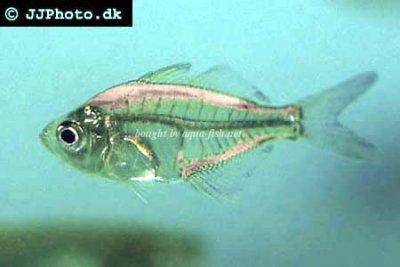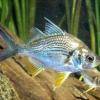Indian glassfish - Parambassis ranga
Scientific name: Parambassis ranga
Common name: Indian glassfish
Family: Ambassidae
Usual size in fish tanks: 5 - 6 cm (1.97 - 2.36 inch)
014
Recommended pH range: 7 - 7.5
Recommended water hardness: 10 - 20°N (178.57 - 357.14ppm)
0°C 32°F30°C 86°F
Recommended temperature range: 20 - 26 °C (68 - 78.8°F)
The way how these fish reproduce: Spawning
Where the species comes from: South Asia
Temperament to its own species: peaceful
Temperament toward other fish species: peaceful
Usual place in the tank: Middle levels
Food and Feeding
The Indian Glassfish (Parambassis ranga) is an omnivorous species that readily accepts most foods offered in the aquarium. To keep them healthy and vibrant, provide a staple diet of high-quality flake food. In addition, supplement their nutrition with protein-rich treats like brine shrimp, bloodworms, daphnia, and tubifex worms 2-3 times per week. Since they feed at mid-tank levels, ensure food reaches this area. Feed them in moderation to avoid overfeeding, which can lead to poor water quality and health issues.
Origin
The Indian Glassfish (Parambassis ranga) is native to South and Southeast Asia, including countries like Pakistan, India, Thailand, and Malaysia. In the wild, they inhabit slow-moving, slightly brackish freshwater rivers, lakes, and streams. To ensure their well-being in captivity, it's essential to mimic these calm, slightly brackish conditions by providing a tank with gentle water flow, plants, and adequate hiding spots.
Sexing
Sexing Indian Glassfish is relatively straightforward. Males display a distinct blue edging on their fins, whereas females have clear, unmarked fins. This difference in coloration becomes more pronounced during the breeding season.
Breeding
To encourage breeding in Indian Glassfish, slightly brackish water conditions can be beneficial. Add a small amount of salt to the breeding tank about two months before spawning to simulate their natural environment. A large water change with fresh water, combined with morning light exposure, helps induce spawning behavior. The female will lay eggs on broad-leaved plants, and the male will guard them until they hatch after several days. Caring for the fry can be challenging, as they are sensitive to water conditions. Offer them infusoria or other tiny live foods immediately after hatching, and gradually introduce larger live foods like brine shrimp as they grow.
Lifespan
With proper care, Parambassis ranga can live for 5-6 years. Maintaining stable water quality, offering a nutritious diet, and providing a stress-free environment are key to maximizing their lifespan. Regular water changes and attention to water parameters, such as pH and salinity, are crucial for their long-term health.
Tank Requirements
Indian Glassfish thrive in aquariums that offer plenty of swimming space and stable water conditions. Keep them in groups in tanks with open swimming areas, along with plants and caves along the sides for hiding. These fish benefit from slightly brackish water conditions, so adding a small amount of salt can improve their health, especially during breeding. Maintain water temperatures between 20-26°C (68-78.8°F) and a pH of 7-7.5. A good filtration system and regular water changes are essential to keeping the water parameters stable.
Short Description
Parambassis ranga, commonly known as the Indian Glassfish, is a small, peaceful species that is well-suited for community tanks. With its transparent body and delicate appearance, it is a popular choice among aquarists. Indian Glassfish prefer to be kept in groups and require a well-planted aquarium with open swimming spaces. Although they can adapt to freshwater conditions, they benefit from the addition of a small amount of salt to their tank, particularly during breeding. This species is a great addition to any peaceful community aquarium.
Picture
Bought by aqua-fish.net from jjphoto.dk.


 Sailfin
Sailfin  Sepik
Sepik  Giant
Giant